We used get matsutake (either North American or Mexican) from a Japanese mail order house but they charge an arm and leg. So this year, I did a web search, found a company in Oregon called "Oregon mushroom, LLC" and decided to give their product a try. This (left upper in the image below) is 1 lb of matsutake, which was sent to us overnight by FedEx and arrived in good condition. It is not too expensive (relatively speaking) at $28/lb but it took almost the same amount of money for the overnight delivery. The matsutake was quite fragrant--more so than what we received previous years from other places. The lovely, characteristically earthy smell wafted out the minute we opened the box. The Matsutake was also quite dirty when it arrived as you can see. Washing it in water is not recommended. I used a moist paper towel and gently rubbed the surface to remove as much of the dirt as I could. I then used a sharp paring knife and sliced off the very bottom, then removed the surface of the bottom end as if I were sharpening a pencil (lots of sands attached). I also removed any embedded dirt and sand (I would rather sacrifice a bit of the mushroom than bite into dirt and sand--something we experienced at some restaurants in the past.) The upper right in the image below is after this cleaning process.
Monday, September 27, 2010
Matsutake steam baked in sake 松茸の酒蒸し焼き
Certain mushrooms are highly prized among gourmands. For the French, it is truffles. For the Japanese, it is matsutake 松 茸 . Japanese domestic matsutake is very scarce since it only grows in pine forests which are apparently disappearing from the Japanese countryside. I learned that Chinese and Korean matsutakes are more common in the Japanese market nowadays. Here in North America, we can get North American or Mexican matsutake. The latter is more expensive since the shape is more similar to the Japanese domestic variety. The flavor, mostly smell, is very subtle but distinctive. Last week, when we were at Tako Grill, we had this season's first matsutake, grilled or "yaki matsutake" 焼き松茸, which prompted me to look into ordering our own supply of matsutake.
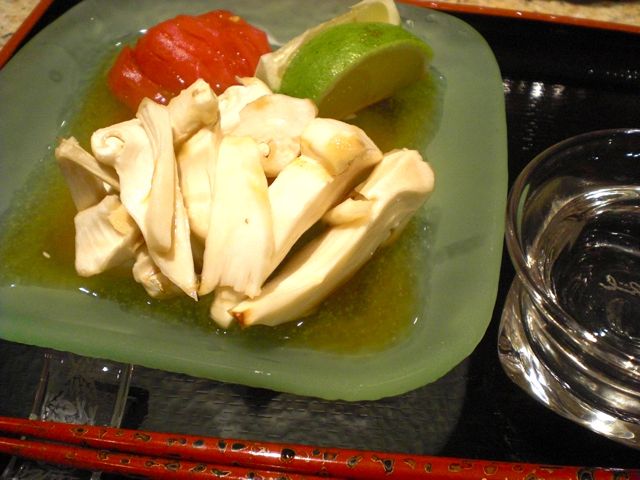
 Since this was a weekday night and we did not have the time or energy to grill matsutake on a charcoal fire, I decided to steam-bake it in an aluminum foil pouch. I first cut into the stem end of the cleaned matsutake and then tore off pieces by hand. I repeated this process until I got reasonably sized pieces (lower left in the above image). I then placed these in a square pouch I made from aluminum foil. I sprinkled sake over the mushrooms and let it be absorbed by the matsutake for a few minutes. I added light-colored or usukuchi shouyu 薄口醤油 (1 tsp) and closed the pouch with enough air space so the steam could rise as it cooks. I placed the pouch in a 500F toaster oven for 5-7 minutes. I did not want to overcook the mushrooms. When the pouch was opened (lower right in the image above), a heavenly earthy aroma of matsutake filled the air. The smell immediately evoked the image of colored leaves and the cool weather of fall. I served the matsutake with the juice accumulated in the bottom of the pouch as a sauce. I added a bit more salt and some lime juice. This has such a subtle and delicate flavor but we have to have it at least once a year because it wouldn't be autumn if we didn't smell it and taste it. You need cold sake with this.
Since this was a weekday night and we did not have the time or energy to grill matsutake on a charcoal fire, I decided to steam-bake it in an aluminum foil pouch. I first cut into the stem end of the cleaned matsutake and then tore off pieces by hand. I repeated this process until I got reasonably sized pieces (lower left in the above image). I then placed these in a square pouch I made from aluminum foil. I sprinkled sake over the mushrooms and let it be absorbed by the matsutake for a few minutes. I added light-colored or usukuchi shouyu 薄口醤油 (1 tsp) and closed the pouch with enough air space so the steam could rise as it cooks. I placed the pouch in a 500F toaster oven for 5-7 minutes. I did not want to overcook the mushrooms. When the pouch was opened (lower right in the image above), a heavenly earthy aroma of matsutake filled the air. The smell immediately evoked the image of colored leaves and the cool weather of fall. I served the matsutake with the juice accumulated in the bottom of the pouch as a sauce. I added a bit more salt and some lime juice. This has such a subtle and delicate flavor but we have to have it at least once a year because it wouldn't be autumn if we didn't smell it and taste it. You need cold sake with this.
Sunday, September 26, 2010
Fajitas ファヒタス
When we had the landscaping done for our new house in California many years ago, all the workers, except for the boss, were from Mexico. They asked if they could use our Weber grill which was kept outside to cook some meals. We said it was OK with us as long as they cleaned up afterward. We assumed they were using it occasionally to cook burgers for their lunch. One weekday evening when we came home from work, they were still there working. They asked if we would like to try "carne asada" with them. We felt a bit funny about this (being invited to dinner at our own house using our own grill). Nonetheless we were curious and accepted the invitation. They quickly and expertly made a fire in the Weber. They produced a skirt steak from the enormous cooler they had with them, seasoned it simply with salt then grilled it over the hot coals. They also warmed up tortillas and served the carne asada, thinly sliced, with a store bought but very tasty and spicy salsa on it. Obviously, they knew the best salsa and tortillas to buy. We all ended up companionably standing around the grill on the concrete slab patio amid the chaos of the on-going landscaping eating our fill. We learned something from that meal. It was very simple yet sophisticated--much more than the burgers we had imagined they were eating. It was also nutritiously well-balanced (meat, starch and vegetables). The best part was how it smelled as it cooked. I still remember how it made my mouth water.
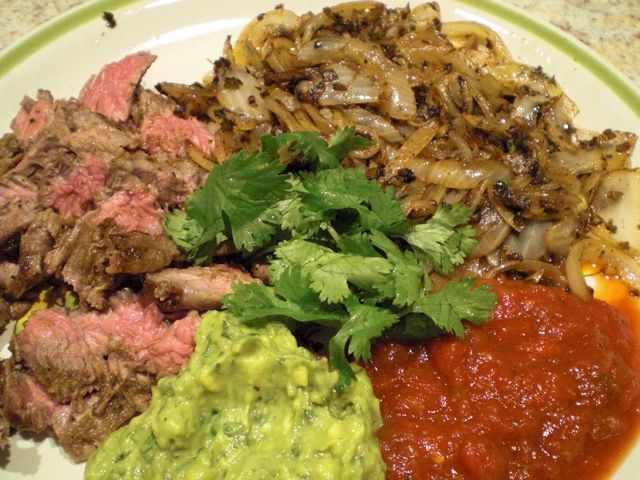
A Tex-Mex version of similar dish is called "fajitas" which is extremely popular in the U.S.. Since I had a package of skirt steak in our refrigerator, I made my version of "fajitas" on Sunday. I was too lazy to fire up the grill outside and made "fajitas" in a skillet (which is the usual way to cook fajitas anyway).
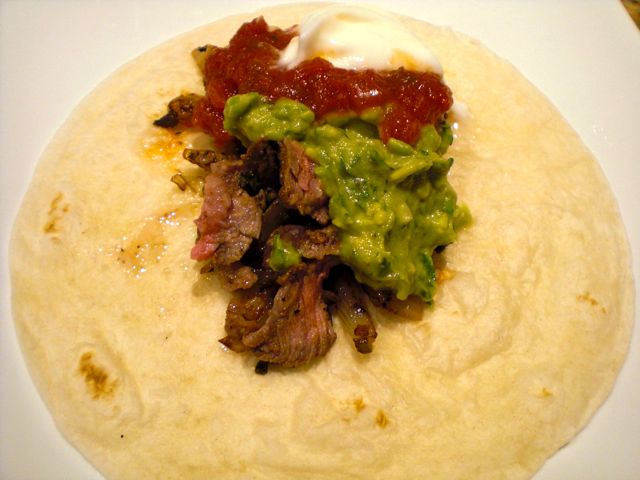
To eat, we warmed small flour tortilla, placed onion, steak, guacamole, salsa on the tortilla and top the whole thing with plain yogurt (or sour cream). We like yogurt, which cuts the heat (spice).
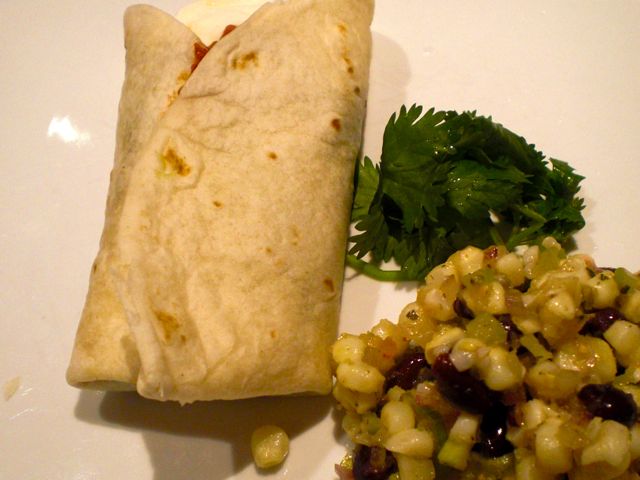
I first rubbed ground cumin, salt and black pepper on the surface of the skirt steak and let it sit for 10-15 minutes. The marinade is lime juice (2 tbs or one lime), olive oil (2 tbs), ground cumin (1 tbs, but use your judgement, we like cumin a lot but it is strong spice), jalapeno pepper (two, seeded and deveined and finely chopped), garlic (3 fat cloves, finely chopped), and fresh cilantro (2-3 tbs, finely chopped including the stem). I also sliced one large onion (halved and then thinly sliced). I placed everything in a Ziploc bag including the meat and let it marinate for several hours or overnight in the refrigerator.
To cook, I took out the steak and if the surface is too wet, I blot it with a paper towel and season it with salt and pepper again (lightly). I use a "grill" pan which has ridges on the bottom to make char marks, and cook the steak for 1 minute on each side for medium (or to your desired doneness) on high flame with a small amount of olive oil. I set the steak aside on a plate and loosely cover it with an aluminum foil. I then cook the onion with all the marinade for 5 minutes on high flame stirring often or until the onion becomes soft and partially browned. I served the steak sliced across the grain, onion, guacamole (homemade), and salsa (store bought, this was not the best. I did not have good tomatoes to make salsa myself).
Roll it up and serve it with black bean corn salad, which was made by my wife a few days ago. We have not had this for a long time and it tasted very good--reminiscent of the one we had in so long ago in California.
Friday, September 24, 2010
Pork filet mignon cutlet 豚のヒレカツ
Over 10 years ago, on one of our visits to Japan, we stayed in Kyoto (as usual) for several days. During this stay, we were taken to a "tonkatsu" トンカツrestaurant (I do not recall the name). As soon as we opened the door, the smell of deep fried pork wafted out and made us salivate. I am sure eating deep fried pork is historically a rather new introduction to Japan but it is a very popular Japanese Western-style dish. Many restaurants specialize in it and each has their secret sauce and/or special pork. Among "tonkatsu", the kind made of tenderloin or fillet mignon of pork called "hirekatsu" ヒレカツ is considered the ultimate. It is unfortunately not particularly dietetic and I have not made this for some time.

Since the weather has been very nice, even chilly in the morning and the evening, I suggested cooking "hirekatsu" outside so that we didn't have to worry about splattering the stove and the lingering smell of deep fry permeating the house. Meanwhile, we could enjoy staying outside. Our set up is shown below. This electric wok is powerful enough to heat the oil over 170C (340F) for proper deep frying.
Breading: I used the usual process of dredging the medallions in AP flour, putting them through a beaten egg/water wash and coating them in Japanese panko. It is best to let it sit in the refrigerator for several hours before frying since the breading will stick better.
Deep frying: As you can see in the picture above, I placed the breaded medallions of pork in the oil when the temperature is about 150C (300F) since the medallions were rather thick, I started with a relatively low temperature. It takes 7-8 minutes turning once. After 4-5 minutes, I cranked up the heat so that the oil temperature reached 170C (340F). When the bubbles around the meat become small, I take out the thickest piece and test to make sure it is done (picture below).
Pennsylvania Dutch style sweet and sour coleslaw: My wife mentioned that the only raw cabbage she ate as a child (and she really liked it) was Pennsylvania Dutch style coleslaw (shown in the little bowel in the lower left of the picture). Since I had never tasted it she decided to make if for me. I helped by chopping up the carrot and cabbage into a fine dice. The dressing calls for vinegar, sugar, egg, salt, butter and cream. It is somewhat similar to Béarnaise sauce but much sweeter. This is how my wife made it; rice vinegar (1/4 cup), sugar (1/2 cup), egg (one beaten, we used pasteurized egg) and butter (1/2 tbs) and cream (1/4 cup). Mix everything (except the cream) in a double boiler. Stirring constantly with a whisk until the sauce becomes thick. Quickly chill the mixture while stirring by putting the pan in an ice water bath. Once the mixture is completely cooled stir in the cream. Add the sauce to the carrot/cabbage mixture and let it sit at least a few hours.
For additional condiments, I also served sweet vinegar, pickled carrot, daikon and cucumber and beer marinated daikon. I also made miso soup with maneko mushroom なめこ, tofu and finely sliced scallion.
The "hirekatsu" was so good with crunchy breading and tender meat. I served it with "Bulldog" brand semi-thick tonkatsu sauce" and a Japanese mustard. You can make your own tonkatus sauce by mixing ketchup and Worcestershire sauce. My wife liked her sweet coleslaw which reminded her of her childhood but it was way too sweet for me. (With all that sugar, is it a surprise kids like it?) I realized I do not like raw cabbage as much as I thought I did. We counteracted the ill effect of the fried food by liberally administering a good Spanish red, Portal del Montsant Santbru 2007 .
Wednesday, September 22, 2010
Japanese sweet vinegar pickles 野菜の甘酢漬け
This is a starter plate we had one evening; crab cake, spinach with creamy black sesame sauce (left and right in the back of the image below) and daikon, cucumber and carrot pickled in sweet vinegar (front).
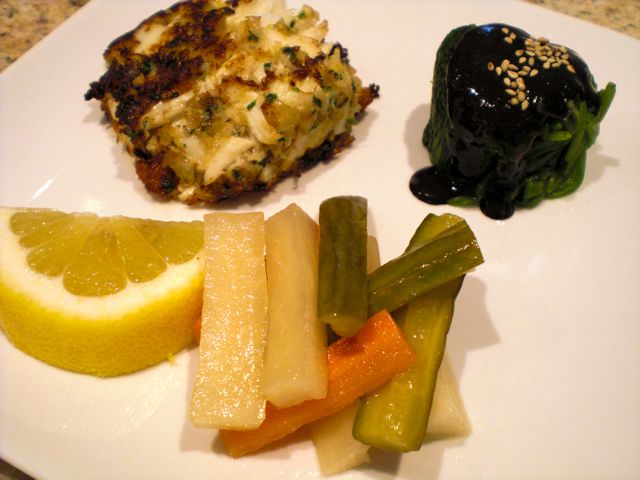
This is a sort of eclectic combination but it happens often with us depending on what is available. Since we had leftover crab meat after making the California roll, I made that into small crab cakes. I got a bunch of fresh spinach (not a baby kind in a bag), so I made spinach with black sesame sauce. I found a bottle of good vinegar tucked in the back of the pantry and used it to make sweet vinegar. I used the sweet vinegar to make a Japanese style chicken escabeche, which followed this plate. The pickled vegetable dish picture here is another dish I made with the sweet vinegar.
Pickling liquid: In the sweet vinegar (1/2 cup), I added yuzu shoyu sauce (1 tbs, from the bottle) and just a dash of dark roasted sesame oil.
Vegetables: I cut daikon, cucumber and carrot into small batons (about 2 inch long and 1/4 inch wide) as seen above. I blanched the carrot for 1 minute and drained. In a frying pan on high flame, I added olive oil (1 tbs) a dash of sesame oil and red pepper flakes. I briefly (30-40 seconds) sauteed all the vegetables and put them in the pickling liquid while it was hot. After cooling down to the room temperature, I covered the container and placed it in the refrigerator. You need to leave the veggies in the pickling liquid at least 24 hours or up to several days.
The pickles in the picture are about 2 days old. The color of the cucumbers is a bit off but all the vegetables were still nicely crunchy with a gentle sweet vinegar taste. Compared to asazuke, these are true Japanese pickles and are a very refreshing condiment.
Monday, September 20, 2010
Chicken breast "nanban", Escabeche Japanese style 鶏胸肉の南蛮
The type of Japanese dish in which fish or meat is first fried and then dressed in a sweet and slightly spicy vinegary sauce is called "nanban" 南蛮. The word "nanban" literally means "southern barbarians". (No offense to the people who used to be classified as "southern barbarians" 南蛮人 by Japanese). Hot red peppers are sometimes called "nanban" indicating they may have come through the southern trade to Japan, in addition, at least two totally different types of Japanese dishes carry the name "nanban". One dish is very similar to escabeche (which is the dish posted here) and it may be that the Portuguese brought this dish to Japan along with Tempura while trading in Nagasaki 長崎, located in Kyushu 九州, the southernmost (main) island of Japan, during the Edo 江戸 period. Another is the noodle and duck dish, "kamo nanban" 鴨南蛮. One theory why this dish is called "nanban" is that this dish also features Japanese scallions or "negi" 葱 and the place near Oosaka 大阪 called "nanba" 難波 used to be famous for its production of "negi". Thus, this dish was originally called "Kamo Nanba" 鴨難波, which somehow became "kamo nanban" but I have no idea if this is correct.
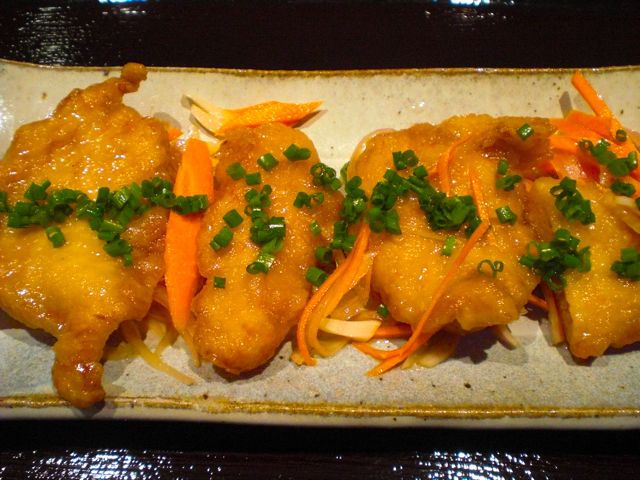
In any case, this Japanese style escabeche or nanban, is best when you use small bony fish. Deep frying and marinating in vinegar makes all the bones edible. The reason I made this dish is two fold; I found a tall bottle of a good quality (made of 100% rice) rice vinegar more than half used on the uppermost shelf of our pantry (since it did not fit to the shelf where I keep the rest of the Japanese items, I totally forgot about it--"out of sight out of mind") and I also discovered that I had chicken breasts which I bought last weekend and they had to be cooked quickly.
Marinating: While the chicken pieces are still hot, add them to the sweet vinegar marinade. I also add thinly sliced red onion, julienned carrot, and red pepper flakes. You should add as much vegetables as you like or the marinade can accommodate. They are very good after pickling. I marinade them at least overnight or longer in the refrigerator.
Sweet vinegar: "Amazu" 甘酢 can be made ahead. It keeps a long time in the refrigerator. I put the aforementioned rice vinegar (it was about 1 and a half cups) in a non-reactive (such as stainless steel or Pyrex) pan on low flame and added sugar (half the amount of vinegar, either by volume or weight) and a small amount (I used 1/2 tsp but could be more) salt. Stir and make sure the sugar is completely dissolved and let it come to boil (called "nikiru" 煮きる), this makes the vinegar mellow. Let it cool down and put it in a plastic or glass container and keep it in the refrigerator. This can be used for many other recipes.
Marinade: I use 2/3 cup of sweet vinegar for one chicken breast. I add dashi (1/4 cup), mirin and soy sauce (1 tbs each). Put it in a sealable flat container to be ready for receiving the chicken.
Chicken: I make thin bite size pieces from one skinless, boneless breast by cutting across the grain of the meat on a slant. I season it with soy sauce and grated ginger (just enough to coat the meat pieces but no extra liquid should remain) and coat each piece of meat by mixing by hand and let it sit for 10-15 minutes at room temperature.
Dredging: I use potato starch or katakurko 片栗粉. This creates a nice even crust which does not come off easily and also produces a nice slippery surface after the cooked chicken is soaked in the vinegar marinade.
Frying: I again used shallow frying at 170C (340F). Since the meat is thin, it takes 1-2 minutes on each side and comes out very crispy but meat becomes kind of dry but that is OK. It is good to eat as is (which we did). It is quite different from the chicken thigh tatsutaage 竜田揚げ and it is very good in its own right.
Marinating: While the chicken pieces are still hot, add them to the sweet vinegar marinade. I also add thinly sliced red onion, julienned carrot, and red pepper flakes. You should add as much vegetables as you like or the marinade can accommodate. They are very good after pickling. I marinade them at least overnight or longer in the refrigerator.
The end result is quite nice. It is a very interesting melding of flavors. The frying cuts the acid of the sweet vinegar and the vinegar cuts the oiliness of the frying. The result is a refreshing dish with real depth. In addition, over time the chicken picks up the flavor of the vegetables with which it is sharing the marinade. The texture of the chicken is nice because the crust from the frying is still intact but develops a nice slippery or smooth surface (but not slimy, for those who have slime-o-phobia). The pickled vegetables are a nice accompaniment. Beer or sake may be a safer pairing but we had this with a Cali cab, Louis.M.Martini Cab Sauv, Alexander valley, Reserve 2007*. This wine has a nice earthy overtone with good firm tannin and went surprisingly well with this dish. The acid in this dish appears not to compete with this wine.
*P.S. Even after it was bought out by Gallo, Louise.M.Martini keeps making reasonably priced good quality wines, we liked their Napa cab and this reserve from Alexander valley (regular cab from Sonoma is so-so). Ghost pine, which is one of the Gallo's numerous brands but made by L.Martini, is also good.
Saturday, September 18, 2010
Enoki mushrooms braised with miso and butter えのき茸のバター味噌
I found a package of fresh enoki mushrooms えのき茸 at the grocery store and made this dish. My wife said she tasted enoki for the first time when I took her to a Robatayaki 炉端焼き restaurant in San Francisco Japantown eons ago on one of our first dates. (The restaurant has been long defunct). I decided to make enoki the way we had it there or the closest approximation of what I remember. They put the enoki and sauce in a pouch made of aluminum foil and grilled it but I cooked this in a frying pan.

I cut off the root end of the enoki and sauteed it in a frying pan on a medium flame with butter. While it was being sauteed, I tried to keep the top and bottom ends together in the same orientation for better presentation. You may have to separate the enoki, since they may be still attached to each other near the root end. Turn them several times to cook evenly for 2 minutes or so. Meanwhile I made a miso broth consisting of dashi (1/4 cup), I used granulated instant dashi with hot water, sake (1tbs), mirin (1tbs) and miso (2 tsp). When, the butter was bubbling and browning slightly, I added the broth and put on a tight lid for 2-3 minutes until the enoki is done. I garnished it with the chopped green parts of scallion and sprinkles of Japanese 7 flavored pepper "Shichimi tougarashi" 七味唐辛子. The butter and sweet miso combination goes so well with enoki mushrooms and took us back the fond memory of the old robatayaki restaurant we liked so much. Such a simple but wonderful dish.
Thursday, September 16, 2010
California roll and smoked salmon sushi カリフォルニア巻きとスモークサーモン寿司
When I posted tekkamaki 鉄火巻き, I said that I often make California roll. My wife corrected this statement by reminding me that I have not made this for ages. So here it is. This was the shime 締め dish for the evening. We also had some leftover smoked salmon (just enough to make two nigiri) so I made two smoked salmon nigiri sushi or nigirizushi にぎり寿司.
This time, I recruited my wife to take the pictures so that I can show each step, (although anybody in their right mind should not follow my instructions for this or any dish).
Since this is uramaki 裏巻き (the rice layer is outside), I spread a thin layer of sushi rice to the edges of the nori sheet (I need not to leave a strip of nori without the rice layer like tekkamaki) (below left). I sprinkle white sesame seeds on the rice (below middle). Now, since this is uramaki, you have to flip over the nori-rice combination. There are several way to do it; 1). Covering one of the bamboo mats or makisu 巻き簾 with plastic wrap on both side and dedicating that mat strictly for uramaki, 2). using a sheet of plastic wrap, and 3) using a moist tea towel. I used the last method but any one of these will work. I align the edge of the tea towel with the edge of the rice/nori (below right) and flip over the nori and tea towel together.
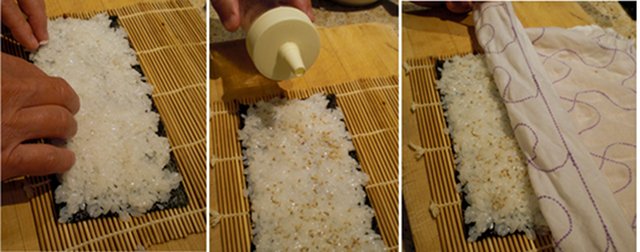

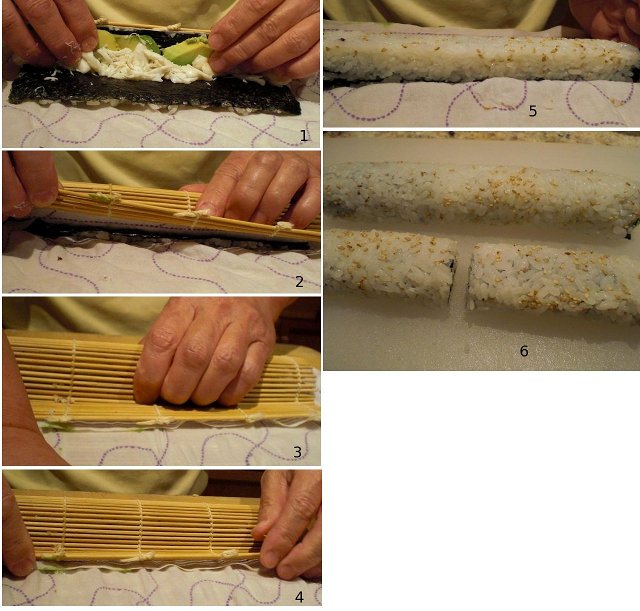 We happened to find wooden sushi serving boards called "sushigeta" 寿司下駄 which we forgot we had in the back of the drawer earlier in the day. It looks like traditional Japanese wooden sandals called "geta" hence its name. I used this to serve the California roll. The avocado was OK but not the best. The crab meat, however, was excellent and (as per my wife), the sushi rice was better than what we often get in sushi bars. Somehow the combination of crab, avocado, sushi rice and nori with soy sauce works very well. No doubt, it is one of the great American contributions to the world of sushi.
We happened to find wooden sushi serving boards called "sushigeta" 寿司下駄 which we forgot we had in the back of the drawer earlier in the day. It looks like traditional Japanese wooden sandals called "geta" hence its name. I used this to serve the California roll. The avocado was OK but not the best. The crab meat, however, was excellent and (as per my wife), the sushi rice was better than what we often get in sushi bars. Somehow the combination of crab, avocado, sushi rice and nori with soy sauce works very well. No doubt, it is one of the great American contributions to the world of sushi.
Make sure the edge of tea towel/nori-rice is aligned with the front edge of the bamboo mat (above left). I smear real wasabi down the center of the nori and put strips of avocado and crab meat as shown in the image above on the right.
While trying to hold the crab and avocado in the middle of the roll, start rolling by lifting the edge of the makisu (#1 below). When I reach the other side of the nori surface (#2), I ease the bamboo mat and pull the tea towel from underneath the roll and while holding the tea towel and the bamboo mat together, roll forward to complete the roll. I grab the far end of the tea towel with my right hand and squeeze the bamboo mat and pull toward me using my left hand while keeping the tea towel in place with my right hand (#3) to make sure it is tightly rolled. I make sure the roll is securely together by evenly squeezing the makisu with both hands (#4). Remove the bamboo mat and the tea towel and you see the completed roll emerges (#5). Slice it using a narrow blade knife (#6) in the same manner as tekkamaki (actually I should have made 4 pieces from the half of the roll instead of three; this tells you I have not made this for a long time.
Subscribe to:
Comments (Atom)

